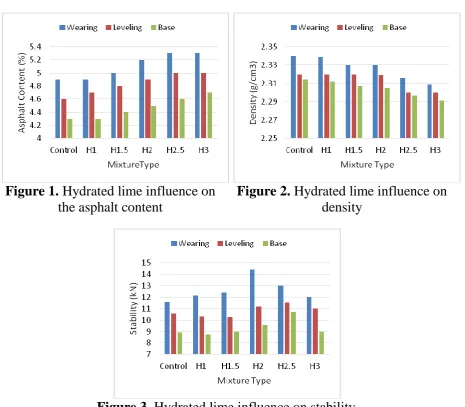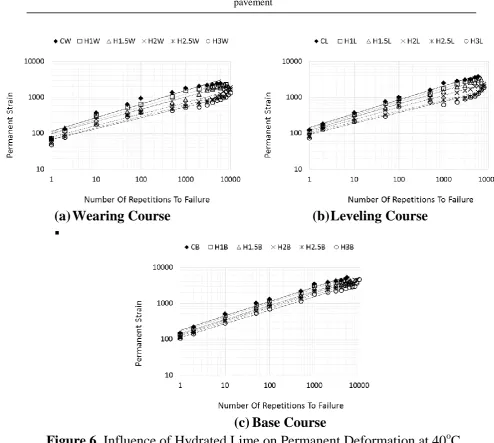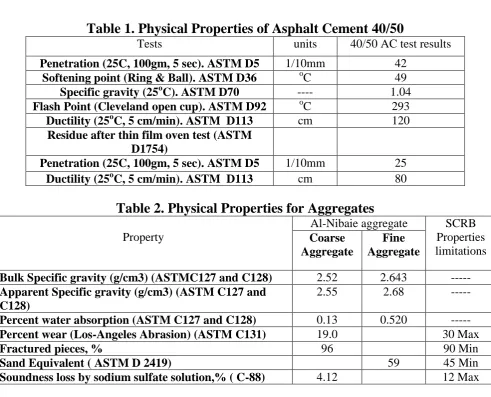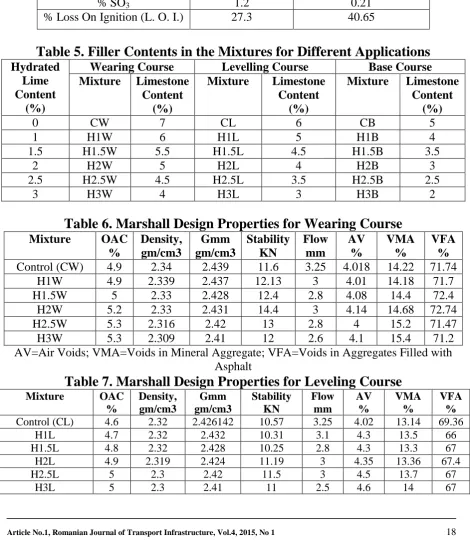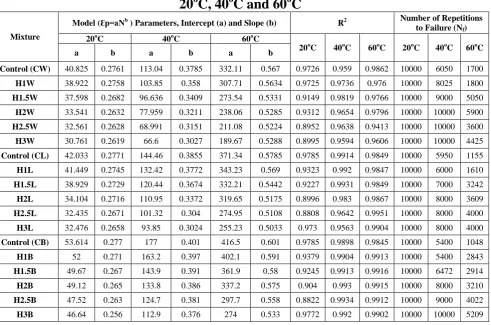c o n c r e t e l ay e r s i n p a v e m e n t
Al-Ta m e e m i, AF, Wa n g , Y a n d Alb a y a ti, A
h t t p :// dx. d oi.o r g / 1 0 . 1 5 1 5 / rj ti-2 0 1 5-0 0 2 7
T i t l e I nfl u e n c e of h y d r a t e d li m e o n t h e p r o p e r ti e s a n d
p e r m a n e n t d ef o r m a ti o n of t h e a s p h al t c o n c r e t e lay e r s in p a v e m e n t
A u t h o r s Al-Ta m e e m i, AF, Wa n g , Y a n d Alb ay a ti, A
Typ e Ar ticl e
U RL T hi s v e r si o n is a v ail a bl e a t :
h t t p :// u sir. s alfo r d . a c . u k /i d/ e p ri n t/ 3 7 5 5 8 /
P u b l i s h e d D a t e 2 0 1 5
U S IR is a d i gi t al c oll e c ti o n of t h e r e s e a r c h o u t p u t of t h e U n iv e r si ty of S alfo r d . W h e r e c o p y ri g h t p e r m i t s , f ull t e x t m a t e r i al h el d i n t h e r e p o si t o r y is m a d e f r e ely a v ail a bl e o nli n e a n d c a n b e r e a d , d o w nl o a d e d a n d c o pi e d fo r n o
n-c o m m e r n-ci al p r iv a t e s t u d y o r r e s e a r n-c h p u r p o s e s . Pl e a s e n-c h e n-c k t h e m a n u s n-c ri p t fo r a n y f u r t h e r c o p y ri g h t r e s t r i c ti o n s .
INFLUENCE OF HYDRATED LIME ON THE PROPERTIES
AND PERMANENT DEFORMATION OF THE ASPHALT
CONCRETE LAYERS IN PAVEMENT
Ahmed F. Al-Tameemi, Assistant Lecturer at Al-Nahrain University, Iraq, PhD researcher at the Engineering Research Centre, School of Computing, Science & Engineering, University of Salford, Manchester UK.
Yu Wang, Engineering Research Centre, School of Computing, Science & Engineering, University of Salford, Manchester UK.
Amjad Albayati, Civil Engineering Department, University of Baghdad, Iraq.
Abstract
Flexible or asphalt concrete pavement is the paving system most widely adopted all over the world. It has been recognized that there are many different types of the factors affecting the performance and durability of asphalt concrete pavement, including the service conditions, such as: the variation of temperature from mild to extremes and the repeated excessive axle loading as well as the inadequate quality of the raw materials. All of these when combined together are going to accelerate the occurrence of distresses in flexible pavement such as permanent deformation and fatigue cracking. As the result, there has an urgent need to enhance the ability of asphalt concrete mixture to resist distresses happened in pavement. Use of additives is one of the techniques adopted to improve pavement properties. It has been found that hydrated lime might be one of the effective additives because it is widely available and relatively cheap compared to other modifiers like polymers. This paper presents an experimental study of the hydrated-lime modified asphalt concrete mixtures. Five different percentages of the hydrated lime additive were investigated, namely (1, 1.5, 2, 2.5 and 3 percent). The hydrated lime additive was used as partial replacement of limestone filler by total weight of the aggregate. The designed Hot Mix Asphalt (HMA) concretes are for the application of three pavement courses, i.e. Surface, Leveling and Base. These mixtures are designed and tested following Marshall procedure and uniaxial repeated loading to evaluate permanent deformation at different temperatures of 20oC, 40oC and 60oC. The experimental results show that the addition of hydrated lime as a partial replacement of ordinary limestone mineral filler results a significant improvement on mechanical properties and the resistant to permanent deformation of the designed asphalt concrete mixtures.
1. INTRODUCTION
enhances the bonding between aggregates and asphalt (Satyakumar et. al., 2013). Using hydrated lime to modify asphalt concrete for practical pavement applications, more information and experimental data are still needed for the sake of the development of design standards. So far, there haven’t had sufficient studies on the combined effects of the mixtures with varied hydrated lime contents under a wide range of the variation of temperature and for different applications. This paper presents an experimental study on the mechanical properties of asphalt concrete with five different percentages of the hydrated lime as partial replacement of the conventional limestone filler. Concrete mixtures are designed for the application of three pavement courses, i.e. Surface or Wearing, Leveling or Binder and Base. Experiments, including the Marshall test and the uniaxial repeated loading test, are conducted to evaluate the resistance to plastic flow and the permanent deformation at three different temperatures of 20oC, 40oC and 60oC. The obtained experimental results are compared and discussed.
2. EXPERIMENTS
2.1. Raw Materials and Mixture
The component materials that used in this research are asphalt cement, aggregates, and fillers (limestone dust and hydrated lime). The physical properties of the asphalt cement and aggregate are listed in Table 1 and 2 respectively. The aggregates (coarse and fine) were sieved and recombined in deferent proportions in terms of the Wearing (Surface), Leveling (Binder) and the Base course gradation specified by Iraqi State Corporation for Roads and Bridges specification (SCRB, R/9 2003).
The physical properties and chemical composition of hydrated lime and limestone are presented in Tables 3 and 4, respectively. Control mixes were prepared using limestone dust as the only mineral filler with the content of 7%, 6% and 5% of the total weight of the mixes. The three percentages are in the mid of the range suggested by the SCRB (R/9 2003) for the three types of applications, i.e.: IIIA, II and I for Wearing, Leveling and Base course, respectively.
mixture has the same aggregate gradation to avoid the variation in physical and mineralogical characters. The hydrated lime contents for the mixtures of the Wearing, Leveling and Base course are listed in the Table 5.
2.2. Experimental Procedure
2.2.1 Marshall Mix Design, Preparation and Test
The mix design and preparation followed the Marshall method as summarized in the manual series No. 2 of Asphalt Institute (AI, 1981) and according to the standard ASTM-D-1559. The asphalt cement percentages by the total weight of the specimens are in the range of 4.3 – 5.5 for the Wearing course, 4.0 – 5.2 for the Leveling course, and 3.7 – 4.9 for the Base course, respectively. Three specimens were made for each percentage. The property results take the average value of the tests of the three. Mixes with an interval of 0.3% in each range were studied. The air void percentage (ASTM D3203), bulk density and specific gravity (ASTM D2726) and the maximum (theoretical) specific gravity (no voids in mix) (ASTM D2041) were calculated in terms of the following definition:
𝐴𝑉 = 𝐺𝑚𝑚−𝐺𝑚𝑏
𝐺𝑚𝑚 (1)
𝐺𝑚𝑏 = 𝑊𝑎
𝑊𝑠𝑠𝑑−𝑊𝑤 (2)
𝐺𝑚𝑚 = 𝐴
𝐴+𝐵−𝐶 (3)
where, AV is the voids in the specimen (%), Gmm is the theoretical maximum specific gravity of loose mixture excluding the air voids (g/cm3), Gmb is the bulk specific gravity of the compacted specimen (g/cm3). Wa is the weight of specimen in air (g), Wssd is the weight of saturated surface dry specimen (g), and
Ww is the weight of specimen in water (g), A is the weight of dry sample in air (g), B is the weight of flask filled with water only at 25°C (g), and C is the weight of flask filled with water and specimen at 25°C (g).
2.2.2. Permanent Deformation Test
repetition was applied in a rectangular wave form with a constant frequency of 1 Hz (0.1 seconds of load duration followed by 0.9 seconds of rest time). The axial permanent deformation was recorded using Linear Variable Differential Transducer (LVDT). The deformation was measured at the upper face of the specimen. The permanent axial deformation were recorded after 1, 2, 10, 100, 500, 1000, 2000, 3000, 4000, 5000, 6000, 7000, 8000, 9000, 10000 times of repetition, respectively, until the specimens failed. The permanent strain is calculated according to the following definition:
𝜀𝑝 =𝑃𝑑∗106
h (4)
Where, εp is the axial permanent strain, pd is the axial permanent deformation, h is the specimen initial height. Throughout the test the resilient deflection is measured at each load repetition of 50 to 100, and then resilient modulus is calculated in terms of the definition below:
𝑀𝑟 = σ
𝜀𝑟 (5)
where, ɛr is the axial resilient strain, rd is the axial resilient deflection, h is the specimen original height, Mr is the resilient modulus, σ is the repeated axial stress. The permanent deformation results are represented in terms of relationship between the permanent strain and the repetition number of load following the description of the Eq. (6) originally suggested by Barksdale (1972) and Monismith et al. (1975), which is a linear function in the form of log-log display
𝜀𝑝 = aNb (6)
where, εp is the permanent strain, N is the number of stress applied, a and b are intercept and slope of the relationship respectively.
2.3. Specimen Nomenclature
3. RESULTS AND DISCUSSION
3.1. Optimum Asphalt Content (OAC)
The data shown in Tables 6-8 indicate that the mixtures with added hydrated lime appear to have a higher asphalt content than the control mixture. The mixtures of H3W, H3L and H3B have the OAC values of 5.3%, 5% and 4.7%, respectively, which are higher than that of the mixtures of less hydrated lime contents. The three control samples for the W, L and B course have the lowest OAC values, which are 4.9%, 4.6% and 4.3%, respectively. The increase of the asphalt cement for the hydrated lime modified mixtures can be attributed to the relatively high specific surface area of hydrated lime, which is about 1.6 times of that of the limestone dust. The high surface area attracts more asphalt cement particles to achieve a more thorough hydration process (Al-Suhaibani et al. 1992, Shahrour and Saloukeh 1992).
3.2. Density
The effect of the addition of hydrated lime on the unit mass of the compacted mixes is shown in Figure 1. It can be seen that the unit mass tends to decrease as the lime content increases. There are two reasons may related to the decrease. The first one is due to the low density of hydrated lime (2.43 gm/cm3) compared with that of the replaced limestone dust (2.71 gm/cm3), while the second one is attributed to the increase of air voids. Generally, the addition of mineral filler tends to increase the viscosity and makes the mixture more stiff. As a result, the degree of compaction may decrease with the increase of hydrated lime content (Fayadh 1987, Al-Suhaibani et al. 1992, Shahrour and Saloukeh 1992, Baig 1995, Tayh and Jabr 2011, Sengul et al. 2011).
3.3. Marshall Stability
Zeng and Wu 2008), a low percentage of hydrated lime has the effect on the improvement of the binding capacity of the mixture. However, when the hydrated lime content is too high, the increase of air voids will result in the decrease of the stability. The results show that the maximum stability value has been increased by 24%, 9% and 20%, with respect to the control mix, for the mixes H2W, H2.5L and H2.5B, respectively. This finding is in agreement with the results of some previous research work (Al-Suhaibani et al. 1992, Albayati 2012, Shahrour and Saloukeh 1992, Baig 1995, Kok and Yilmaz 2009, Tayh and Jabr 2011).
3.4. Resilient Modulus
The resilient modulus can be worked out in terms of the Eq. (5) using the recorded stress-strain relationship. The resilient modulus at different temperatures with respect to the addition of hydrated lime for the course W, L and B mixes are presented in Figure 4. It can be seen that relatively high resilient modulus has been achieved by the mixtures of the added hydrated lime with a content in the range of 1.0 to 3.0% at the three temperatures of 20oC, 40oC and 60oC. However, in general, the modulus decreases with the increase of temperature. In detail, the modulus increases with the added content of hydrated lime for all the three types of course mixtures at the low temperature of 20oC. However, for the W and L mixtures, the modulus shows a decrease with the increase of temperature at the high hydrated lime content. In general, the properties will deteriorate with the increase of temperature.
3.5. Permanent Deformation
3.5.1. Effect of Hydrated Lime on Permanent deformation
Petersen (2005) pointed out that hydrated lime is chemically inactive at low temperature, and, as a result, it helps to develop a significant rutting resistance. The results from Figs. 5-7 show that at a relatively low temperature, such as 20oC, the permanent strain is low for all the mixtures and the effect of the variation of the hydrated lime content is not significant, however, at a relatively high temperature, such as 40oC and 60oC, the hydrated lime content displays an effective influence, particularly, at 40oC and for the course W and L, the effect of the hydrated lime content is more pronounced.
3.5.2. Models’ parameters and Number of repetition to Failure
Based on the model Equation (6), Table 9 demonstrates the permanent deformation model parameters; intercept (a) and slope (b) for Wearing, Leveling and Base courses at 20oC, 40oC and 60oC for a series of hydrated lime addition percentages. The table shows also the coefficient of determination of each equation and the number of repetitions to failure for each mixture. In general, it can be seen that there is a reduction in intercept (a) by addition of HL and the slope (b) of the linear trend decreases with the increase of the hydrated lime with a variety in the influence due to change in mixture type and temperature of the test. The repetitions to failure increased as a result of HL modification in intermediate and high temperatures (40oC and 60oC).
4. CONCLUSIONS
The follow conclusions can be drawn from the results.
1. The addition of hydrated lime will enhance the Marshall properties as well as increase the demand of asphalt cement. The addition of 2%, 2.5% and 2.5% hydrated lime displays the most effective improvement on the Marshall properties for the Wearing, Leveling and Base mixtures, respectively.
2. The addition of hydrated lime up to 2.5% will increase resilient modulus for all the mixes at the temperature of 20oC, 40oC and 60oC. However, over 3% hydrated lime addition shows a slight decrease in stiffness. It can be concluded that the temperature has a significant influence on the HMA properties.
ACKNOWLEDGE
This work is a part of an on-going PhD project funded by the Iraqi Ministry of Higher Education and Scientific Research, Scholarship Program.
REFERENCES
[1]. “AASHTO Guide for Design of Pavement Structures”. The American Association of
State Highway and Transportation Officials, Washington, D.C., USA. 1993.
[2]. “AASHTO Standard Specification for Mineral Filler for Bituminous Paving
Mixtures”. AASHTO Designation: M 17-07, American Association of State
Highways and Transportation Officials, Washington, D.C. 2007.
[3]. ASPHALT INSTITUTE, “Thickness Design-Asphalt Pavements for Highways and
Streets”, Manual Series No.1, College Park, Maryland, USA. 1981.
[4]. ALBAYATI A., , “Mechanistic Evaluation of Lime-Modified Asphalt Concrete
Mixtures”, 7th RILEM International Conference on Cracking in Pavements, ed. by A. Scarpas, N. Kringos, I. Al-Qadi and L. A, Springer Netherlands. 4: 921-940. 2012.
[5]. ALBAYATI A. AND AHMED M. “Assessment the Impact of Different Hydrated
Lime Addition Methods on Fatigue Life Characteristic”, Eng. & Tech. Journal, 31: 489-511. 2013.
[6]. AL-SUHAIBANI A., AL-MUDAIHEEM J. AND AL-FOZAN F., “Effect of Filler
Type and Content on Properties of Asphalt Concrete Mixes”, in SPT 1147 Effects of Aggregates and Mineral Fillers on Asphalt Mixtures Performance, ed. By R. C.
Meininger, ASTM, Philadelphia PA, 107–130. 1992.
[7]. ASTM, “Road and Paving Materials, Annual Book of ASTM Standards, Volume
04.03”, American Society for Testing and Materials, West Conshohocken, USA.
2004.
[8]. BAIG, M. G., “Laboratory Evaluation of Hedmanite and Lime Modified Asphalt
Concrete Mixes”, M.Sc. Thesis, Civil Engineering, King Fahd University of Petroleum & Minerals, Dhahran, Saudi Arabia. 1995.
[9]. FAYADH, S. S., “Hydrated lime and Rubber as Additives in Asphalt Paving
Mixtures”, M.Sc thesis, Civil Engineering, University of Baghdad, Iraq. 1987.
[10]. HARRIS, B.M. AND STUART, K.D., “Analysis of Mineral Fillers and Mastics
[11]. KIM Y. R., LITTLE D. N. AND SONG I., “Effect of Mineral Fillers on Fatigue
Resistance and Fundamental Material Characteristics Mechanistic Evaluation”,
Transportation Research Record: Journal of the Transportation Research Board, 1:
1-8, 2003.
[12]. KOK, B. V. AND YILMAZ M., “The Effects of Using Lime and Styrene–Butadiene–
Styrene on Moisture Sensitivity Resistance of Hot Mix Asphalt”, Journal of
Construction and Building Materials,23: 1999-2006, 2009.
[13]. LITTLE D. N. EPPS J. A. AND SEBAALY P. E., “The Benefits of Hydrated Lime in
Hot Mix Asphalt”, National Lime Association, 2006.
[14]. LITTLE D. N. AND PETERSON J. C., “Unique Effects of Hydrated Lime Filler on
the Performance-Related Properties of Asphalt Cements: Physical and Chemical Interactions Revisited”, Journal of Materials in Civil Engineering, 17: 207-218, 2005.
[15]. SATYAKUMAR M., CHANDRAN R. S. AND MAHESH M. S., “Influence of
Mineral Fillers on the Properties of Hot Mix Asphalt”, International Journal of Civil
Engineering and Technology, 4: 99-110, 2013.
[16]. MOHAMMAD L. N., ABADIE C., GOKMEN R. AND PUPPALA A. J.,
“Mechanistic Evaluation of hydrated Lime in Hot-Mix Asphalt Mixtures”, Transportation Research Record: Journal of the Transportation Research Board, 1723: 33-39, 2000.
[17]. SADY A. TAYH AND AQEEL R. JABR, “The Effect of Filler Type on the Hot Mix
Asphalt Behavior”, Eng. & Tech. Journal, Vol. 29, No.9, pp. 1701- 1720, 2011.
[18]. SCRB/R9, “General Specification for Roads and Bridges, Section R/9, Hot-Mix
Asphalt Concrete Pavement”, Revised Edition. State Corporation of Roads and
Bridges, Ministry of Housing and Construction, Republic of Iraq, 2003.
[19]. SEBAALY P. E., HILTY E. AND WEIZEL D., “Effectiveness Of Lime In Hot Mix
Asphalt Pavement”, University of Nevada, Reno, USA, 2001.
[20]. SENGUL C.,E., AKSOY A., ISKENDER E. AND OZEN H., “Hydrated Lime
Treatment Of Asphalt Concrete To Increase Permanent Deformation Resistance”,
Journal of Construction and Building Materials 30: 139-148, 2011.
[21]. SHAHROUR A. M., AND SALOUKE, G. B., “Effect of Quality and Quantity of
[22]. ZENG M. AND WU C., “Effects of Type and Content of Mineral Filler on Viscosity
of Asphalt Mastic and Mixing and Compaction Temperatures of Asphalt Mixture”, Transportation Research Record: Journal of the Transportation Research Board, 2051: 31-40, 2008.
Figure 1. Hydrated lime influence on the asphalt content
[image:13.595.71.537.251.658.2]Figure 2. Hydrated lime influence on density
a) 20oC b) 40oC
[image:14.595.73.533.129.532.2]c) 60oC
a) Wearing Course b) Leveling Course
c) Base Course
(a)Wearing Course (b)Leveling Course
[image:16.595.44.539.118.561.2](c)Base Course
Table 1. Physical Properties of Asphalt Cement 40/50
Tests units 40/50 AC test results
Penetration (25C, 100gm, 5 sec). ASTM D5 1/10mm 42
Softening point (Ring & Ball). ASTM D36 oC 49
Specific gravity (25oC). ASTM D70 ---- 1.04
Flash Point (Cleveland open cup). ASTM D92 oC 293
Ductility (25oC, 5 cm/min). ASTM D113 cm 120
Residue after thin film oven test (ASTM D1754)
Penetration (25C, 100gm, 5 sec). ASTM D5 1/10mm 25
Ductility (25oC, 5 cm/min). ASTM D113 cm 80
Table 2. Physical Properties for Aggregates
Property
Al-Nibaie aggregate SCRB
Properties limitations
Coarse Aggregate
Fine Aggregate
Bulk Specific gravity (g/cm3) (ASTMC127 and C128) 2.52 2.643 ---
Apparent Specific gravity (g/cm3) (ASTM C127 and C128)
2.55 2.68 ---
Percent water absorption (ASTM C127 and C128) 0.13 0.520 ---
Percent wear (Los-Angeles Abrasion) (ASTM C131) 19.0 30 Max
Fractured pieces, % 96 90 Min
Sand Equivalent ( ASTM D 2419) 59 45 Min
Soundness loss by sodium sulfate solution,% ( C-88) 4.12 12 Max
Table 3. Physical Properties of Hydrated Lime and Limestone Material property Hydrated lime Limestone
dust(filler)
Specific gravity(gm./cm3) 2.43 2.71
Specific surface (m2/Kg) 394 246
-100 Mesh (150 μm), % 100 100
Table 4. Chemical Composition of Hydrated Lime and Limestone Chemical composition Limestone Hydrated lime
% CaO 68.3 56.1
% SiO2 2.23 1.38
% Al2O3 - 0.72
% Fe2O3 - 0.12
% MgO 0.32 0.13
% SO3 1.2 0.21
[image:19.595.64.535.261.807.2]% Loss On Ignition (L. O. I.) 27.3 40.65
Table 5. Filler Contents in the Mixtures for Different Applications Hydrated
Lime Content
(%)
Wearing Course Levelling Course Base Course Mixture Limestone
Content (%)
Mixture Limestone Content
(%)
Mixture Limestone Content
(%)
0 CW 7 CL 6 CB 5
1 H1W 6 H1L 5 H1B 4
1.5 H1.5W 5.5 H1.5L 4.5 H1.5B 3.5
2 H2W 5 H2L 4 H2B 3
2.5 H2.5W 4.5 H2.5L 3.5 H2.5B 2.5
3 H3W 4 H3L 3 H3B 2
Table 6. Marshall Design Properties for Wearing Course Mixture OAC
% Density, gm/cm3 Gmm gm/cm3 Stability KN Flow mm AV % VMA % VFA %
Control (CW) 4.9 2.34 2.439 11.6 3.25 4.018 14.22 71.74
H1W 4.9 2.339 2.437 12.13 3 4.01 14.18 71.7
H1.5W 5 2.33 2.428 12.4 2.8 4.08 14.4 72.4
H2W 5.2 2.33 2.431 14.4 3 4.14 14.68 72.74
H2.5W 5.3 2.316 2.42 13 2.8 4 15.2 71.47
H3W 5.3 2.309 2.41 12 2.6 4.1 15.4 71.2
AV=Air Voids; VMA=Voids in Mineral Aggregate; VFA=Voids in Aggregates Filled with Asphalt
Table 7. Marshall Design Properties for Leveling Course
Mixture OAC
% Density, gm/cm3 Gmm gm/cm3 Stability KN Flow mm AV % VMA % VFA %
Control (CL) 4.6 2.32 2.426142 10.57 3.25 4.02 13.14 69.36
H1L 4.7 2.32 2.432 10.31 3.1 4.3 13.5 66
H1.5L 4.8 2.32 2.428 10.25 2.8 4.3 13.3 67
H2L 4.9 2.319 2.424 11.19 3 4.35 13.36 67.4
H2.5L 5 2.3 2.42 11.5 3 4.5 13.7 67
Table 8. Marshall Design Properties for Base Course
Mixture OAC
% Density, gm/cm3 Gmm gm/cm3 Stability KN Flow mm AV % VMA % VFA %
Control (CB) 4.3 2.314 2.418251 8.9 2.92 4.29 14 69.35 H1B 4.3 2.312 2.415861 8.77 2.7 4.28 13.99 69.39
H1.5B 4.4 2.307 2.41 9 2.5 4.5 14.3 69
H2B 4.5 2.305 2.406 9.6 2.4 4.2 14.39 70
H2.5B 4.6 2.297 2.403 10.7 2.45 4.39 14.67 70.06
H3B 4.7 2.291 2.4 9 2.3 4.55 15 70.1
Table 9. Permanent deformation models’ parameters for all mixtures at 20oC, 40oC and 60oC
Mixture
Model (Ɛp=aNb ) Parameters, Intercept (a) and Slope (b) R2 Number of Repetitions to Failure (Nf)
20oC 40oC 60oC
20oC 40oC 60oC 20oC 40oC 60oC
a b a b a b
Control (CW) 40.825 0.2761 113.04 0.3785 332.11 0.567 0.9726 0.959 0.9862 10000 6050 1700
H1W 38.922 0.2758 103.85 0.358 307.71 0.5634 0.9725 0.9736 0.976 10000 8025 1800
H1.5W 37.598 0.2682 96.636 0.3409 273.54 0.5331 0.9149 0.9819 0.9766 10000 9000 5050
H2W 33.541 0.2632 77.959 0.3211 238.06 0.5285 0.9312 0.9654 0.9796 10000 10000 5900
H2.5W 32.561 0.2628 68.991 0.3151 211.08 0.5224 0.8952 0.9638 0.9413 10000 10000 3600
H3W 30.761 0.2619 66.6 0.3027 189.67 0.5288 0.8995 0.9594 0.9606 10000 10000 4425
Control (CL) 42.033 0.2771 144.46 0.3855 371.34 0.5785 0.9785 0.9914 0.9849 10000 5950 1155
H1L 41.449 0.2745 132.42 0.3772 343.23 0.569 0.9323 0.992 0.9847 10000 6000 1610
H1.5L 38.929 0.2729 120.44 0.3674 332.21 0.5442 0.9227 0.9931 0.9849 10000 7000 3242
H2L 34.104 0.2716 110.95 0.3372 319.65 0.5175 0.8996 0.983 0.9867 10000 8000 3609
H2.5L 32.435 0.2671 101.32 0.304 274.95 0.5108 0.8808 0.9642 0.9951 10000 8000 4000
H3L 32.476 0.2658 93.85 0.3024 255.23 0.5033 0.973 0.9563 0.9904 10000 8000 4000
Control (CB) 53.614 0.277 177 0.401 416.5 0.601 0.9785 0.9898 0.9845 10000 5400 1048
H1B 52 0.271 163.2 0.397 402.1 0.591 0.9379 0.9904 0.9913 10000 5400 2843
H1.5B 49.67 0.267 143.9 0.391 361.9 0.58 0.9245 0.9913 0.9916 10000 6472 2914
H2B 49.12 0.265 133.8 0.386 337.2 0.575 0.904 0.993 0.9915 10000 8000 3210
H2.5B 47.52 0.263 124.7 0.381 297.7 0.558 0.8822 0.9934 0.9912 10000 9000 4022
[image:20.595.57.549.326.651.2]